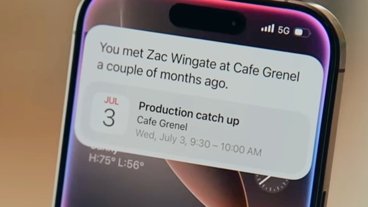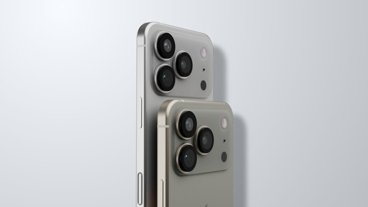The fastest growing segment in global smartphones isn't Google's vision for super-cheap, simple Android phones. Instead, according to new market data, it's refurbished high-quality phones that carry a desirable brand but can be sold at a more affordable price, a segment where Apple is "leading by a significant margin."
A report by Counterpoint Research noted that "the global market for refurbished smartphones grew 13 percent year over year in 2017, reaching close to 140 million units," and contrasted this against the larger market for new smartphones, which grew by barely 3 percent during the year, or just 33.8 million units.
Apple's unit sales of new iPhones last year were flat; in the December quarter, the number sold actually slipped slightly (-1 percent), although much less than the 5 percent drop suffered by the industry at large. However, despite shipping fewer boxes, Apple actually earned 13 percent higher revenues by selling more higher-tier products, including "super premium" iPhone 8 and iPhone X models priced starting at $699 and $999, respectively.
Among Android licensees, the retracting volume of unit sales was financially disastrous because most manufacturers were already making very little to nothing selling low-end and middle-tier phones. As sales become harder to sustain, competition among poorly-differentiated, commodity Androids gets increasingly cutthroat.
This has already forced over one hundred discount phone makers out of business in China, after pushing many PC makers such as HP out of the handset business. Analysts expect a further Battle Royale to occur among commodity Android smartphone makers this year.
While cheap commodity phone makers fight over scraps, the strength of Apple's premium devices is allowing them to return to the market to compete again in a second wave, following a trend that occurred among luxury carmakers selling their certified pre-owned vehicles directly in competition with new, entry-level economy cars.
"The Surprising Growth of Used Smartphones"
Counterpoint's report on the refurbished phone business highlighted that "only 25 percent of all pre-owned phones are sold back into the market," and added that "of these, only some are refurbished.""The mid low-end market for new smartphones is being cannibalized by refurbished high-end phones, mostly Apple iPhones"
However, those refurbished models are having a big impact on the market. Counterpoint Research Director Tom Kang stated, "with 13 percent growth, refurbished smartphones are now close to 10 percent of the total global smartphone market."
The extended lifespan and resale cycle of existing iPhones is commonly cited as a potential threat to Apple's future sales growth. However, Kang pointed out that "the low growth of the new smartphone market in 2017 can be partially attributed to the growth of the refurb market. The slowdown in innovation has made two-year-old flagship smartphones comparable in design and features with the most recent mid-range phones.
"Therefore, the mid low-end market for new smartphones is being cannibalized by refurbished high-end phones, mostly Apple iPhones and, to a lesser extent, Samsung Galaxy smartphones."
One factor that gives Apple an advantage in selling refurbished iPhones to users who might not be able to afford a brand new one, and would otherwise likely buy a lower-priced Android, is the fact that it supports its hardware with iOS updates for four or five years, rather than less than a year or two as is common among Android makers— even including Google itself.
New iPhones also ship with fast processors and a modern, efficient iOS. Androids, particularly low-priced models, are sold with underperforming chips and often ship with old versions of an OS that is already bad at managing memory and CPU tasks.
Faster segment growth than India, and "Apple leads by a significant margin"
Counterpoint stated that Apple and Samsung's dominance "is more obvious in the refurb market than in the new smartphone market," noting that the two companies account for "close to three-fourths of the refurbished smartphone market [by unit volume], with Apple leading by a significant margin." "It's a surprise to many that the fastest growing smartphone market in 2017 was not India or any other emerging market, but the refurb market"
By revenue, "the dominance grows further, as the two smartphone giants control more than 80 percent of the revenue in the refurbished smartphone market."
The firm's Research Director Peter Richardson stated, "it's a surprise to many that the fastest growing smartphone market in 2017 was not India or any other emerging market, but the refurb market. With refurb smartphones in play we think the market for new devices will slow further in 2018."
Richardson added, "regions seeing the highest volume include the US and Europe, while the fastest growing markets for refurbs include Africa, SE Asia and India. All have been seeing initiatives from the major operators (e.g. Verizon, Vodafone etc.), OEMs (e.g. Apple) and major distributors (e.g. Brightstar) who are adding full life-cycle services.
"The industry uses data analysis to predict future resale values of devices, which means consumers can be given a guaranteed buy-back value at various points during their ownership. This helps consumers to manage the high cost of the latest flagship smartphones - or at least to obtain a useful contribution to partially offset the cost of their next phone."
 Daniel Eran Dilger
Daniel Eran Dilger









-m.jpg)






 Mike Wuerthele
Mike Wuerthele
 Malcolm Owen
Malcolm Owen

 Amber Neely
Amber Neely
 William Gallagher
William Gallagher




-m.jpg)





67 Comments
Seeing as android makers regularly discount, why get a refurb?
It's a booming market alright, the only drawback I've seen is a reduction in resale prices of 2nd hand iPhones. When the 8 was released, the 6S model was trading privately for around £200 - people are still asking for this today. Just checking MusicMagpie for example; I can buy a refurbished 6S 16GB for just £129 with 12months warranty.
Edit* - it's actually just £124 with cashback offer and a refurbished iPhone SE 16gb (with 12month warranty again) is just £94 on the same offer. madness
Few days before successor announcement, I sold my Galaxy S8 for financial reasons, and bought 128GB iPhone 7. If someone told me I would be this satisfied and happy, I probably wouldn’t belive it!😉 But it is running great! I was using iPhones up until the SE before making a switch. Glad to be back and bezels seem overrated now, I don’t see them at all after Galaxy belive it or not!😊
Bottom line, not suprised by this news.😉
Once again, Dilger hits the nail on the head. Apple has long been 'recommended' to move into the lower markets, long before it even began selling iPhone. Apple only works on profitability, and it seems to me that refurbs are Apple's way of moving mid-teir. Selling last year's model for a small discount was the best way to move downward, but to also keep the customer base growing. But Apple's most significant business solution to a saturated market, I reckon, is the huge investments Apple's made in Services. Whereever or whenever what ever model iPhone is bought, the App Store, iTunes etc etc all provide a revenue stream back into Apple. Apple has done fantastically well to not only plan all this out, but to execute the plan extremely well. I can not see any competitor arising for Apple within the next ten years.